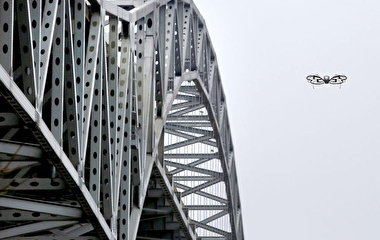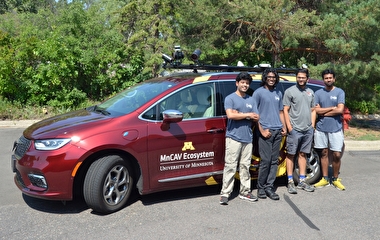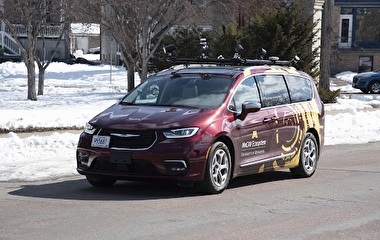Self-driving cars, driverless cars, robo-cars—whatever you label them, the popularity of autonomous vehicles is on the rise. But how about taking the sensor technology that allows these machines to detect incoming objects and applying it to bicycles?
smart bicycle. Photo: Olivia Hultgren
That’s exactly what U of M mechanical engineering professor Rajesh Rajamani is doing, on a shoestring budget of $500 per bicycle.
Rajamani and team are developing a smart bicycle with an attached alert system that sounds a horn when cars get too close to the cyclist. The system comprises three sensors that monitor the trajectories of nearby vehicles, speakers, and a black-box camera that records video when the cyclist is in danger.
The initial prototype was developed with funding from the Roadway Safety Institute. Now, with a nearly $1 million National Science Foundation grant, Rajamani’s team is collaborating with cycling manufacturer Quality Bicycle Products (QBP) to test the technology.
According to the National Highway Traffic Safety Administration, traffic crashes resulted in more than 800 cyclist fatalities in the United States in 2018. Rajamani’s goal is to reduce these bicycle-car collisions—but also to minimize cost.
“Because there’s so much work on autonomous vehicles and self-driving cars right now, there’s always this question of how is your work different?” he explains. “The difference is that for a bicycle, the cost constraints are a lot more.”
Similar technology in self-driving cars can cost up to $80,000. Plus, most cars on the road right now don’t have sensing systems, which puts cyclists at risk.
“Bicyclists are the vulnerable users, because obviously the car is not going to get hurt in a bicycle-car collision,” Rajamani says. “Bicyclists can choose to have this technology and protect themselves, so they aren’t dependent on the cars on the road to have sensors.”
Rajamani is working closely with Nichole Morris, director of the U’s HumanFIRST Laboratory, to ensure that the alert system is user-centric—or in this case, cyclist-centric.
Through focus groups, the researchers found that the most pressing concern for frequent bicyclists was being struck by right-turning vehicles at intersections, which led to the incorporation of sensors that would better detect this threat.
“This project presents an important research opportunity to not only help bicyclists communicate what their safety needs are on the road, but also to help improve the design of the collision-warning system based on user feedback,” Morris says.
One of her lab’s biggest contributions was creating an auditory alarm that would induce a sense of urgency in response from drivers. When drivers hear the typical “beep” of a horn, their reflex is to look behind them for another vehicle. This alert needed to have enough “bikeness” to make drivers look for something other than a car, Morris said.
Morris added that this research is a perfect example of how the work of engineering psychologists can complement that of other engineers, especially when systems hinge on human interaction and safety. “We all bring a unique skillset to a problem that just couldn’t have been accomplished working in isolation,” she says.
Both the HumanFIRST Lab and Rajamani’s team have been working with local cyclists to test out the alert system since October 2019. After more testing this spring, the researchers hope to have a marketable product for urban commuters.
(By Olivia Hultgren; adapted and reprinted with permission from the College of Science and Engineering, Jan. 2020.)



